
A poppy is a flowering plant in the subfamily Papaveroideae of the family Papaveraceae. Poppies are herbaceous plants, often grown for their colourful flowers. One species of poppy, Papaver somniferum, is the source of the narcotic drug mixture opium which contains powerful medicinal alkaloids such as morphine and has been used since ancient times as an analgesic and narcotic medicinal and recreational drug. It also produces edible seeds. Following the trench warfare in the poppy fields of Flanders, Belgium during World War I, poppies have become a symbol of remembrance of soldiers who have died during wartime, especially in the UK, Canada, Australia, New Zealand and other Commonwealth realms.

The Torrey pine is a rare pine species in California, United States. It is a critically endangered species growing only in coastal San Diego County, and on Santa Rosa Island, offshore from Santa Barbara in Santa Barbara County. The Torrey pine is endemic to the California coastal sage and chaparral ecoregion.

The Papaveraceae are an economically important family of about 42 genera and approximately 775 known species of flowering plants in the order Ranunculales, informally known as the poppy family. The family is cosmopolitan, occurring in temperate and subtropical climates, but almost unknown in the tropics. Most are herbaceous plants, but a few are shrubs and small trees. The family currently includes two groups that have been considered to be separate families: Fumariaceae and Pteridophyllaceae.

Dendromecon, the tree poppy, is a genus of one or two species of shrubs to small trees, native to California and northern Baja California.

The Arboretum & Botanic Garden at the University of California, Santa Cruz, is located on the campus of the University of California, Santa Cruz, in the United States.

Dendromecon rigida, also called bush poppy or tree poppy, is a shrub or small tree of the Papaveraceae native to California and Baja California.
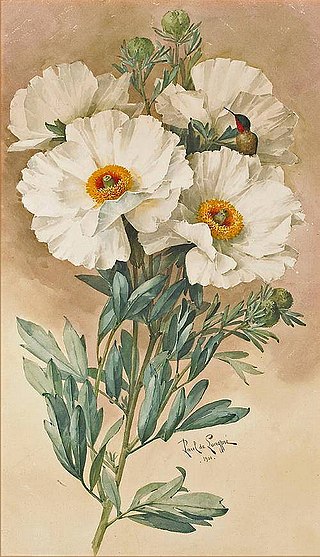
Romneya coulteri, the Coulter's Matilija poppy or California tree poppy, is a perennial species of flowering plant in the poppy family Papaveraceae. Native to southern California, USA, and Baja California, Mexico, it grows in dry canyons in chaparral and coastal sage scrub plant communities, sometimes in areas recently burned. It is a popular ornamental plant, kept for its large, showy flowers.
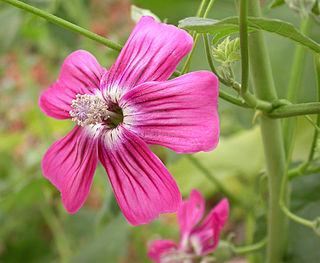
Malva assurgentiflora, formerly classified as Lavatera assurgentiflora, the island mallow, mission mallow, royal mallow, malva rosa island mallow, island tree mallow or malva rosa in Spanish, is a species of flowering plant in the mallow family.

Arctostaphylos catalinae, known by the common name Santa Catalina Island manzanita, is a species of manzanita native to Southern California.

Quercus × macdonaldii, formerly Quercus macdonaldii, with the common names MacDonald's oak and Macdonald oak, is a rare hybrid species of oak in the family Fagaceae.

Eriogonum arborescens is a species of wild buckwheat known by the common name Santa Cruz Island buckwheat.
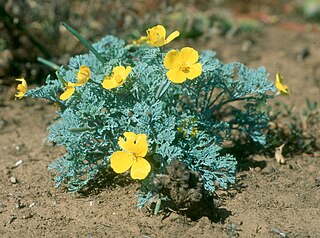
Eschscholzia ramosa is a species of poppy known by the common name Channel Islands poppy, or simply island poppy.

Allium praecox is a species of wild onion known by the common name early onion.
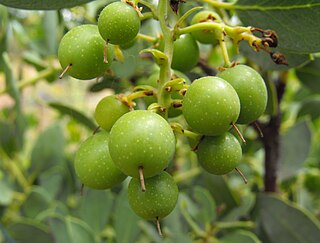
Arctostaphylos rainbowensis is a species of manzanita known by the common name Rainbow manzanita. It is endemic to California, where it is known only from northern San Diego and southern Riverside Counties in the Peninsular Ranges.

Crossosoma californicum, known by the common name California rockflower, is one of only a few species in the flowering plant family Crossosomataceae.

Acmispon argophyllus, synonym Lotus argophyllus, is a species of legume native to California and northwest Mexico. It is known by the common name silver bird's-foot trefoil or silver lotus.

Ribes thacherianum, with the common name Santa Cruz gooseberry, or Santa Cruz Island gooseberry, is a rare North American species of currant found only on one island off the coast of California.
Rupertia rigida is a species of flowering plant in the legume family known by the common name Parish's California tea, or Parish's rupertia.
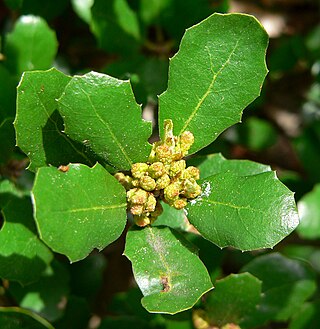
Quercus pacifica is a species of oak known by the common names island scrub oak, Channel Island scrub oak, and Pacific oak.
The wildlife of the Channel Islands of California is wide and diverse, including many endemic species. While the land wildlife is slightly limited, there being only one large, naturally predatory, and native mammal, the small island fox, marine life can include anything from kelp forests to great white sharks.



















